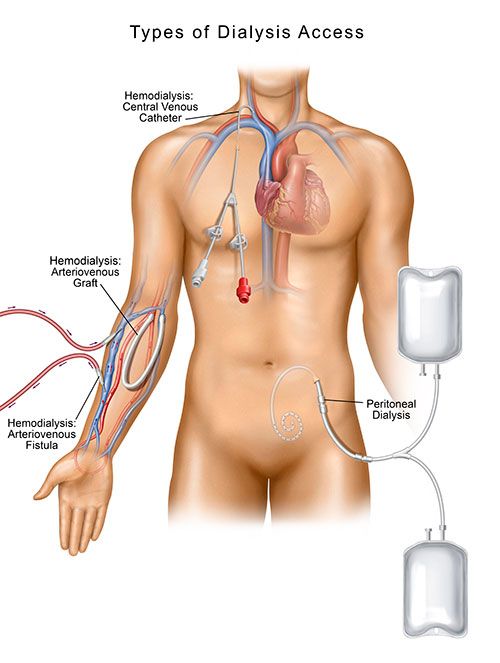
Did you or a loved one recently have a dialysis access placed or created in preparation for starting dialysis? Now that you have one, you need to know how to take care of it. A well-functioning dialysis access site is critical to both your treatment and your overall health.
While the type of access you have will largely determine how you care for it, some tips apply to all access types. The four types of dialysis access are:
- Central venous catheter (CVC) – typically used as a temporary access until another more permanent access is ready for use
- Arteriovenous (AV) fistula – the access most often recommended
- Arteriovenous (AV) graft – the next best choice for those patients whose veins are not large enough or healthy enough for an AV fistula
- Peritoneal (PD) catheter – for those who have selected peritoneal dialysis as their form of renal replacement therapy

Download Our Guide: Know The 3 Dialysis Access Types
10 Tips to Keep Your Dialysis Access Site Working
Taking care of your access will eventually become second nature – something you just do every day, like brushing your teeth. But in the beginning, you’ll want to pay close attention to the following 10 tips, every day, until the habits form. These basics will help you maintain your access so it continues to function well, allowing you to receive hemodialysis treatments that meet your dialysis prescription.
1. Become informed. Read all the pertinent educational materials provided by your healthcare team, as well as any relevant information you find on reputable websites.
2. Keep your access area clean. Avoiding contamination and infection is critical to maintaining a well-functioning access. So wash your hands both before and after you touch your AV fistula or graft. If you have a CVC or PD catheter, which are more prone to infection than AV fistulas and grafts, it’s important to keep in mind you should not touch your access dressing. Patients with catheters have a significantly higher mortality risk than patients with AV fistulas or AV grafts. In one study of 616 new dialysis patients, the risks of death were 50% greater for catheters and 20% greater for grafts when compared to AV fistulas,i so avoiding infection is extremely important.
3. Don’t sleep on your access. Lying on your AV fistula or graft puts pressure on it. This pressure may cause your access to clot.
4. Don’t wear anything constrictive over or near your dialysis access site. This includes jewelry, watches and clothing. Wearing constricting items over your AV fistula or graft can cause undue pressure, increasing the risk for your access to clot.
5. Don’t carry heavy items. Don’t carry heavy items, like groceries, purses or backpacks, over the arm with your AV fistula or graft to avoid putting extra pressure on your access. Being conscious of this will decrease the risk that your access will be damaged. ii
6. Protect your access. Don’t put your access at risk by subjecting it to activities in which you could cut, scrape or damage it.
7. Feel the thrill. Feeling the thrill in your AV fistula or graft every day will give you confidence of knowing it’s functioning properly. Here’s how to feel the thrill:
- Open your hand on the arm opposite the access and hold it out flat.
- Gently place your flat hand, fingers and all, over your fistula or graft.
- If you feel a constant, buzzing vibration, everything is fine.
- If you feel a pulsing or throbbing, call your healthcare team. ii,iii
8. Listen for the bruit. Put your ear to your access, either by bringing your head to your arm or your arm to your ear. A constant swishing sound indicates that everything is working well. If you hear a whistling sound, or if the swishing sound is intermittent or pulsing, call your doctor immediately. ii,iii
9. Clean, clean, clean. Keep the limb with your fistula or graft clean at all times, and especially just prior to your dialysis treatment. Immediately before starting your treatment, wash your access arm or leg with anti-bacterial soap.
10. Be your own advocate. Don’t let anyone take your blood pressure, draw blood, or put in an intravenous (IV) line in your access arm. And never let anyone use your access for anything other than dialysis. ii
RELATED: What should you do if your dialysis access is not working properly?
Just like dialysis helps keep you healthy, properly caring for your access will keep it healthy. So remember to follow these easy tips on a daily basis. And be sure to let your doctors and dialysis team know if you experience any complications with your dialysis access site. Quick action is imperative to ensure further, more drastic complications do not occur.
Sources:
i Drew, DA. “Vascular Access Choice in Incident Hemodialysis Patients: A Decision Analysis.” J Am Soc Nephrol. 2015 Jan; 26(1): 183–191.
ii The National Kidney Foundation. Hemodialysis Access. Accessed from:
https://www.kidney.org/atoz/content/hemoaccess
iii Fistula First. Accessed from: http://fistulafirst.esrdncc.org/wp-content/uploads/2014/06/Final-Assessment-of-the-Newly-Placed-AVF-for-Maturation-04-09-10.pdf


